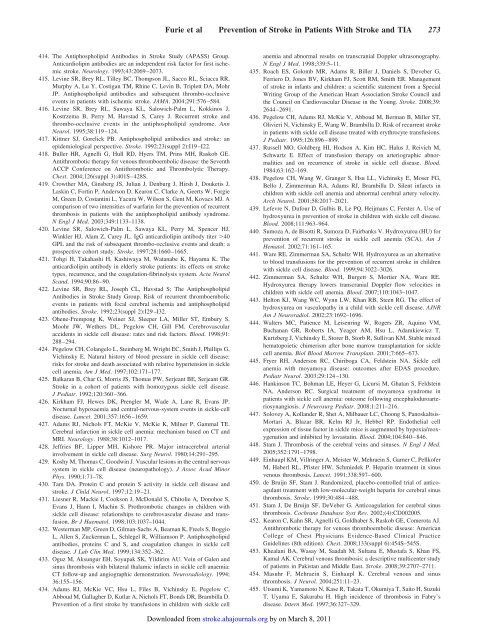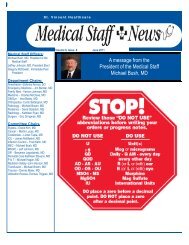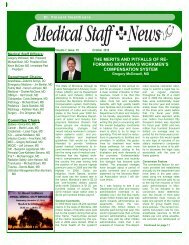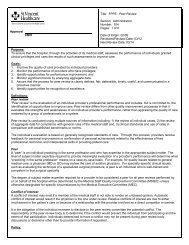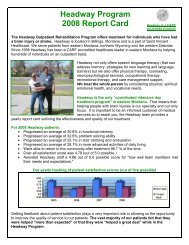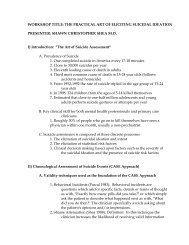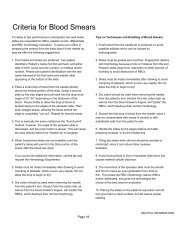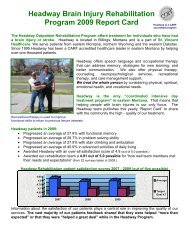AHA/ASA Guideline Guidelines for the Prevention of Stroke in ...
AHA/ASA Guideline Guidelines for the Prevention of Stroke in ...
AHA/ASA Guideline Guidelines for the Prevention of Stroke in ...
Create successful ePaper yourself
Turn your PDF publications into a flip-book with our unique Google optimized e-Paper software.
Furie et al <strong>Prevention</strong> <strong>of</strong> <strong>Stroke</strong> <strong>in</strong> Patients With <strong>Stroke</strong> and TIA 273414. The Antiphospholipid Antibodies <strong>in</strong> <strong>Stroke</strong> Study (APASS) Group.Anticardiolip<strong>in</strong> antibodies are an <strong>in</strong>dependent risk factor <strong>for</strong> first ischemicstroke. Neurology. 1993;43:2069–2073.415. Lev<strong>in</strong>e SR, Brey RL, Tilley BC, Thompson JL, Sacco RL, Sciacca RR,Murphy A, Lu Y, Costigan TM, Rh<strong>in</strong>e C, Lev<strong>in</strong> B, Triplett DA, MohrJP. Antiphospholipid antibodies and subsequent thrombo-occlusiveevents <strong>in</strong> patients with ischemic stroke. JAMA. 2004;291:576–584.416. Lev<strong>in</strong>e SR, Brey RL, Sawaya KL, Salowich-Palm L, Kokk<strong>in</strong>os J,Kostrzema B, Perry M, Havstad S, Carey J. Recurrent stroke andthrombo-occlusive events <strong>in</strong> <strong>the</strong> antiphospholipid syndrome. AnnNeurol. 1995;38:119–124.417. Kittner SJ, Gorelick PB. Antiphospholipid antibodies and stroke: anepidemiological perspective. <strong>Stroke</strong>. 1992;23(suppl 2):I19–I22.418. Buller HR, Agnelli G, Hull RD, Hyers TM, Pr<strong>in</strong>s MH, Raskob GE.Antithrombotic <strong>the</strong>rapy <strong>for</strong> venous thromboembolic disease: <strong>the</strong> SeventhACCP Conference on Antithrombotic and Thrombolytic Therapy.Chest. 2004;126(suppl 3):401S–428S.419. Crow<strong>the</strong>r MA, G<strong>in</strong>sberg JS, Julian J, Denburg J, Hirsh J, Douketis J,Lask<strong>in</strong> C, Fort<strong>in</strong> P, Anderson D, Kearon C, Clarke A, Geerts W, ForgieM, Green D, Costant<strong>in</strong>i L, Yacura W, Wilson S, Gent M, Kovacs MJ. Acomparison <strong>of</strong> two <strong>in</strong>tensities <strong>of</strong> warfar<strong>in</strong> <strong>for</strong> <strong>the</strong> prevention <strong>of</strong> recurrentthrombosis <strong>in</strong> patients with <strong>the</strong> antiphospholipid antibody syndrome.N Engl J Med. 2003;349:1133–1138.420. Lev<strong>in</strong>e SR, Salowich-Palm L, Sawaya KL, Perry M, Spencer HJ,W<strong>in</strong>kler HJ, Alam Z, Carey JL. IgG anticardiolip<strong>in</strong> antibody titer 40GPL and <strong>the</strong> risk <strong>of</strong> subsequent thrombo-occlusive events and death: aprospective cohort study. <strong>Stroke</strong>. 1997;28:1660–1665.421. Tohgi H, Takahashi H, Kashiwaya M, Watanabe K, Hayama K. Theanticardiolip<strong>in</strong> antibody <strong>in</strong> elderly stroke patients: its effects on stroketypes, recurrence, and <strong>the</strong> coagulation-fibr<strong>in</strong>olysis system. Acta NeurolScand. 1994;90:86–90.422. Lev<strong>in</strong>e SR, Brey RL, Joseph CL, Havstad S; The AntiphospholipidAntibodies <strong>in</strong> <strong>Stroke</strong> Study Group. Risk <strong>of</strong> recurrent thromboembolicevents <strong>in</strong> patients with focal cerebral ischemia and antiphospholipidantibodies. <strong>Stroke</strong>. 1992;23(suppl 2):I29–I32.423. Ohene-Frempong K, We<strong>in</strong>er SJ, Sleeper LA, Miller ST, Embury S,Moohr JW, We<strong>the</strong>rs DL, Pegelow CH, Gill FM. Cerebrovascularaccidents <strong>in</strong> sickle cell disease: rates and risk factors. Blood. 1998;91:288–294.424. Pegelow CH, Colangelo L, Ste<strong>in</strong>berg M, Wright EC, Smith J, Phillips G,Vich<strong>in</strong>sky E. Natural history <strong>of</strong> blood pressure <strong>in</strong> sickle cell disease:risks <strong>for</strong> stroke and death associated with relative hypertension <strong>in</strong> sicklecell anemia. Am J Med. 1997;102:171–177.425. Balkaran B, Char G, Morris JS, Thomas PW, Serjeant BE, Serjeant GR.<strong>Stroke</strong> <strong>in</strong> a cohort <strong>of</strong> patients with homozygous sickle cell disease.J Pediatr. 1992;120:360–366.426. Kirkham FJ, Hewes DK, Prengler M, Wade A, Lane R, Evans JP.Nocturnal hypoxaemia and central-nervous-system events <strong>in</strong> sickle-celldisease. Lancet. 2001;357:1656–1659.427. Adams RJ, Nichols FT, McKie V, McKie K, Milner P, Gammal TE.Cerebral <strong>in</strong>farction <strong>in</strong> sickle cell anemia: mechanism based on CT andMRI. Neurology. 1988;38:1012–1017.428. Jeffries BF, Lipper MH, Kishore PR. Major <strong>in</strong>tracerebral arterial<strong>in</strong>volvement <strong>in</strong> sickle cell disease. Surg Neurol. 1980;14:291–295.429. Koshy M, Thomas C, Goodw<strong>in</strong> J. Vascular lesions <strong>in</strong> <strong>the</strong> central nervoussystem <strong>in</strong> sickle cell disease (neuropathology). J Assoc Acad M<strong>in</strong>orPhys. 1990;1:71–78.430. Tam DA. Prote<strong>in</strong> C and prote<strong>in</strong> S activity <strong>in</strong> sickle cell disease andstroke. J Child Neurol. 1997;12:19–21.431. Liesner R, Mackie I, Cookson J, McDonald S, Chitolie A, Donohoe S,Evans J, Hann I, Mach<strong>in</strong> S. Prothrombotic changes <strong>in</strong> children withsickle cell disease: relationships to cerebrovascular disease and transfusion.Br J Haematol. 1998;103:1037–1044.432. Westerman MP, Green D, Gilman-Sachs A, Beaman K, Freels S, BoggioL, Allen S, Zuckerman L, Schlegel R, Williamson P. Antiphospholipidantibodies, prote<strong>in</strong>s C and S, and coagulation changes <strong>in</strong> sickle celldisease. J Lab Cl<strong>in</strong> Med. 1999;134:352–362.433. Oguz M, Aksungur EH, Soyupak SK, Yildirim AU. Ve<strong>in</strong> <strong>of</strong> Galen ands<strong>in</strong>us thrombosis with bilateral thalamic <strong>in</strong>farcts <strong>in</strong> sickle cell anaemia:CT follow-up and angiographic demonstration. Neuroradiology. 1994;36:155–156.434. Adams RJ, McKie VC, Hsu L, Files B, Vich<strong>in</strong>sky E, Pegelow C,Abboud M, Gallagher D, Kutlar A, Nichols FT, Bonds DR, Brambilla D.<strong>Prevention</strong> <strong>of</strong> a first stroke by transfusions <strong>in</strong> children with sickle cellanemia and abnormal results on transcranial Doppler ultrasonography.N Engl J Med. 1998;339:5–11.435. Roach ES, Golomb MR, Adams R, Biller J, Daniels S, Deveber G,Ferriero D, Jones BV, Kirkham FJ, Scott RM, Smith ER. Management<strong>of</strong> stroke <strong>in</strong> <strong>in</strong>fants and children: a scientific statement from a SpecialWrit<strong>in</strong>g Group <strong>of</strong> <strong>the</strong> American Heart Association <strong>Stroke</strong> Council and<strong>the</strong> Council on Cardiovascular Disease <strong>in</strong> <strong>the</strong> Young. <strong>Stroke</strong>. 2008;39:2644–2691.436. Pegelow CH, Adams RJ, McKie V, Abboud M, Berman B, Miller ST,Olivieri N, Vich<strong>in</strong>sky E, Wang W, Brambilla D. Risk <strong>of</strong> recurrent stroke<strong>in</strong> patients with sickle cell disease treated with erythrocyte transfusions.J Pediatr. 1995;126:896–899.437. Russell MO, Goldberg HI, Hodson A, Kim HC, Halus J, Reivich M,Schwartz E. Effect <strong>of</strong> transfusion <strong>the</strong>rapy on arteriographic abnormalitiesand on recurrence <strong>of</strong> stroke <strong>in</strong> sickle cell disease. Blood.1984;63:162–169.438. Pegelow CH, Wang W, Granger S, Hsu LL, Vich<strong>in</strong>sky E, Moser FG,Bello J, Zimmerman RA, Adams RJ, Brambilla D. Silent <strong>in</strong>farcts <strong>in</strong>children with sickle cell anemia and abnormal cerebral artery velocity.Arch Neurol. 2001;58:2017–2021.439. Lefevre N, Dufour D, Gulbis B, Le PQ, Heijmans C, Ferster A. Use <strong>of</strong>hydroxyurea <strong>in</strong> prevention <strong>of</strong> stroke <strong>in</strong> children with sickle cell disease.Blood. 2008;111:963–964.440. Sumoza A, de Bisotti R, Sumoza D, Fairbanks V. Hydroxyurea (HU) <strong>for</strong>prevention <strong>of</strong> recurrent stroke <strong>in</strong> sickle cell anemia (SCA). Am JHematol. 2002;71:161–165.441. Ware RE, Zimmerman SA, Schultz WH. Hydroxyurea as an alternativeto blood transfusions <strong>for</strong> <strong>the</strong> prevention <strong>of</strong> recurrent stroke <strong>in</strong> childrenwith sickle cell disease. Blood. 1999;94:3022–3026.442. Zimmerman SA, Schultz WH, Burgett S, Mortier NA, Ware RE.Hydroxyurea <strong>the</strong>rapy lowers transcranial Doppler flow velocities <strong>in</strong>children with sickle cell anemia. Blood. 2007;110:1043–1047.443. Helton KJ, Wang WC, Wynn LW, Khan RB, Steen RG. The effect <strong>of</strong>hydroxyurea on vasculopathy <strong>in</strong> a child with sickle cell disease. AJNRAm J Neuroradiol. 2002;23:1692–1696.444. Walters MC, Patience M, Leisenr<strong>in</strong>g W, Rogers ZR, Aqu<strong>in</strong>o VM,Buchanan GR, Roberts IA, Yeager AM, Hsu L, Adamkiewicz T,Kurtzberg J, Vich<strong>in</strong>sky E, Storer B, Storb R, Sullivan KM. Stable mixedhematopoietic chimerism after bone marrow transplantation <strong>for</strong> sicklecell anemia. Biol Blood Marrow Transplant. 2001;7:665–673.445. Fryer RH, Anderson RC, Chiriboga CA, Feldste<strong>in</strong> NA. Sickle cellanemia with moyamoya disease: outcomes after EDAS procedure.Pediatr Neurol. 2003;29:124–130.446. Hank<strong>in</strong>son TC, Bohman LE, Heyer G, Licursi M, Ghatan S, Feldste<strong>in</strong>NA, Anderson RC. Surgical treatment <strong>of</strong> moyamoya syndrome <strong>in</strong>patients with sickle cell anemia: outcome follow<strong>in</strong>g encephaloduroarteriosynangiosis.J Neurosurg Pediatr. 2008;1:211–216.447. Solovey A, Kollander R, Shet A, Milbauer LC, Choong S, Panoskaltsis-Mortari A, Blazar BR, Kelm RJ Jr, Hebbel RP. Endo<strong>the</strong>lial cellexpression <strong>of</strong> tissue factor <strong>in</strong> sickle mice is augmented by hypoxia/reoxygenationand <strong>in</strong>hibited by lovastat<strong>in</strong>. Blood. 2004;104:840–846.448. Stam J. Thrombosis <strong>of</strong> <strong>the</strong> cerebral ve<strong>in</strong>s and s<strong>in</strong>uses. N Engl J Med.2005;352:1791–1798.449. E<strong>in</strong>haupl KM, Villr<strong>in</strong>ger A, Meister W, Mehrae<strong>in</strong> S, Garner C, Pellk<strong>of</strong>erM, Haberl RL, Pfister HW, Schmiedek P. Hepar<strong>in</strong> treatment <strong>in</strong> s<strong>in</strong>usvenous thrombosis. Lancet. 1991;338:597–600.450. de Bruijn SF, Stam J. Randomized, placebo-controlled trial <strong>of</strong> anticoagulanttreatment with low-molecular-weight hepar<strong>in</strong> <strong>for</strong> cerebral s<strong>in</strong>usthrombosis. <strong>Stroke</strong>. 1999;30:484–488.451. Stam J, De Bruijn SF, DeVeber G. Anticoagulation <strong>for</strong> cerebral s<strong>in</strong>usthrombosis. Cochrane Database Syst Rev. 2002;(4):CD002005.452. Kearon C, Kahn SR, Agnelli G, Goldhaber S, Raskob GE, Comerota AJ.Antithrombotic <strong>the</strong>rapy <strong>for</strong> venous thromboembolic disease: AmericanCollege <strong>of</strong> Chest Physicians Evidence-Based Cl<strong>in</strong>ical Practice<strong>Guidel<strong>in</strong>e</strong>s (8th edition). Chest. 2008;133(suppl 6):454S–545S.453. Khealani BA, Wasay M, Saadah M, Sultana E, Mustafa S, Khan FS,Kamal AK. Cerebral venous thrombosis: a descriptive multicenter study<strong>of</strong> patients <strong>in</strong> Pakistan and Middle East. <strong>Stroke</strong>. 2008;39:2707–2711.454. Masuhr F, Mehrae<strong>in</strong> S, E<strong>in</strong>haupl K. Cerebral venous and s<strong>in</strong>usthrombosis. J Neurol. 2004;251:11–23.455. Utsumi K, Yamamoto N, Kase R, Takata T, Okumiya T, Saito H, SuzukiT, Uyama E, Sakuraba H. High <strong>in</strong>cidence <strong>of</strong> thrombosis <strong>in</strong> Fabry’sdisease. Intern Med. 1997;36:327–329.Downloaded from stroke.ahajournals.org by on March 8, 2011


